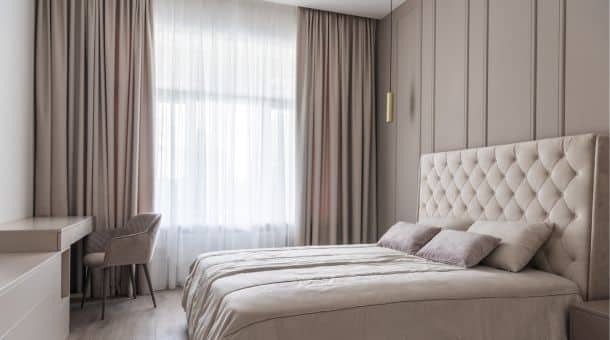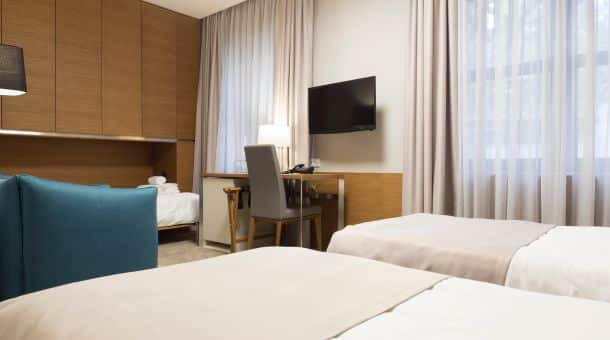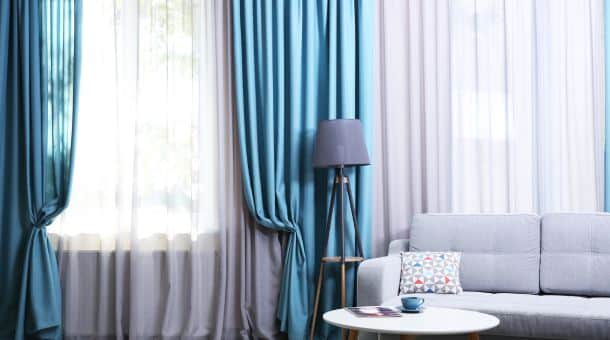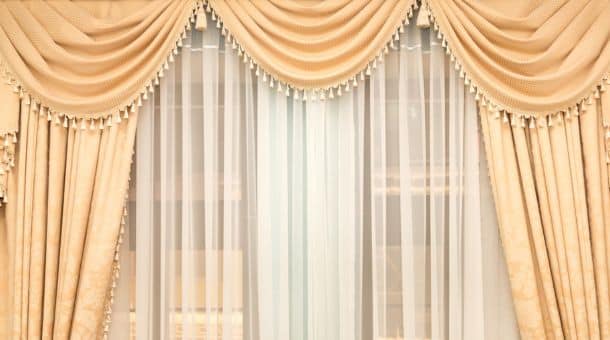As the daylight wanes, the curtains become the guardians of privacy and ambiance within the room. Crafted from a rich, velvety fabric, they drape elegantly, casting a sense of timeless allure upon the space. The deep midnight blue evokes a sense of tranquility reminiscent of a starlit sky.
As gentle zephyrs sweep through the room, the curtains sway gracefully, their movements akin to a delicate dance, orchestrating a symphony of shadows and light. Embroidered patterns, reminiscent of intricate lacework, add sophistication, casting detailed silhouettes upon the floor as the evening progresses.
In the glow of a dimmed lamp, the curtains take on a mystic allure, their depths concealing secrets and stories within their folds. They are a barrier against the outside world, wrapping the room in a sanctuary of comfort and serenity.
In every moment, the curtains are more than just fabric hanging from a rod. They reflect the ever-changing landscape outside, a canvas upon which light and shadow paint their masterpiece and a sanctuary where beauty and serenity intertwine.

Curtain Fabric Choices
Choosing the suitable curtain fabric involves considering various factors, such as the room’s purpose, decor style, desired level of privacy, and light control. Here are some popular curtain fabric choices along with their characteristics:
Cotton: Cotton is a versatile and breathable fabric suitable for most rooms. It’s easy to clean and comes in various weights and weaves, offering options from sheer to opaque curtains.
Linen: Linen has a natural texture and a relaxed, casual look. It allows light to filter through while providing some privacy. Linen curtains add an organic, airy feel to spaces.
Silk: Silk curtains exude luxury and elegance. They have a smooth texture and a lustrous sheen, making them ideal for formal rooms. However, silk requires delicate care and may fade or deteriorate in direct sunlight.
Velvet: Velvet curtains create a rich and abundant ambiance. They offer excellent light-blocking properties and insulation, making them suitable for bedrooms or theaters. Velvet adds warmth and texture to any room.
Polyester: Polyester is durable and affordable in various patterns and textures. It’s easy to maintain and resistant to wrinkles and fading. However, some polyester curtains may drape differently than natural fabrics.
Sheer: Fabrics like chiffon or voile allow plenty of natural light to filter through while providing minimal privacy. They’re perfect for creating an airy and romantic atmosphere, especially in living rooms or sunrooms.
Blackout: Blackout curtain feature multiple layers of tightly woven fabric to block out light completely. They’re ideal for bedrooms, nurseries, or media rooms where darkness is desired. Blackout curtains also provide insulation against noise and temperature fluctuations.
Blend Fabrics: Many curtains are made from fabric blends, such as cotton-polyester mixes, combining the best qualities of each material. These curtain are often more affordable and more accessible to maintain than natural fabrics.
When choosing curtain fabric, consider the room’s function, the light you want to let in, your desired level of privacy, and the overall aesthetic you wish to achieve. Additionally, consider practical considerations like ease of cleaning and durability to ensure your curtains remain functional and beautiful for years.
Curtain lengths and styles
Choosing the right curtain length and style can significantly impact the overall look and functionality of a room’s décor. Here are some standard curtain lengths and styles, along with considerations for each:
Lengths:
Floor-Length: These curtains extend to the floor, creating a traditional and elegant look. They’re suitable for formal rooms like dining rooms and living rooms. Ensure they’re just touching the floor or have a slight break for a polished appearance.
Puddle: Puddle curtains are longer than floor-length curtain pooling or “puddling” on the floor. This luxurious style adds drama and sophistication to formal spaces like grand living rooms or bedrooms. Remember that puddle curtains require extra fabric and may collect dust more easily.
Apron Length: Apron-length curtain fall just below the window sill. They’re ideal for casual spaces like kitchens or bathrooms, providing privacy without overwhelming the room. Make sure they don’t cover heating vents or radiators.
Café Length: Café curtain cover only the bottom half or third of the window, allowing plenty of natural light while preserving privacy. They’re commonly used in kitchens or bathrooms, adding a charming touch to these spaces.
Sill Length: Sill-length curtain end at the window sill, offering a clean and tailored look. They’re versatile and work well in both formal and casual rooms. Ensure they don’t interfere with window hardware or trim.
Styles:
Rod Pocket: Rod pocket curtains have a pocket at the top through which the curtain rod is threaded. This style creates a gathered, casual look and is suitable for lightweight fabrics. Remember that rod pocket curtains can be challenging to open and close, especially with heavier fabrics.
Grommet: Grommet curtains have metal rings along the top edge through which the curtain rod is threaded. They offer a modern and streamlined appearance with smooth and easy operation. Grommet curtains work well with medium- to heavyweight fabrics.
Tab Top: Tab top curtains feature fabric loops or tabs along the top through which the curtain rod is threaded. This style adds a decorative touch and works best with lightweight to medium-weight fabrics. Tab-top curtains offer easy maneuverability.
Pinch Pleat: Pinch pleat curtains have evenly spaced pleats sewn across the top, creating a tailored and formal look. This classic style works well with medium- to heavyweight fabrics and requires curtain hooks or rings for hanging.
Eyelet/Ring Top: Eyelet or ring top curtains have metal rings sewn along the leading edge, providing a contemporary and stylish appearance. They offer smooth operation and are suitable for various fabric weights.
When selecting curtain lengths and styles, consider the room’s décor, functionality, and personal preference. Experimenting with combinations can help you achieve the perfect look for your space.

Curtain Hardware and Accessories
Choosing the proper curtain hardware and accessories is essential for functionality and aesthetics. Here are some common types of curtain hardware and accessories:
Curtain Rods:
Standard Rods: Basic curtain rods come in various materials, such as metal, wood, or plastic. They typically have finials on each end for decoration.
Decorative Rods: Decorative rods often feature ornate finials or decorative elements along the rod itself. They add style and personality to your curtain and complement your room’s décor.
Tension Rods: Tension rods use spring tension to stay in place without the need for screws or mounting hardware. They’re ideal for lightweight curtains or temporary installations.
Double Rods: Double curtain rods have two parallel rods, allowing you to hang two layers of curtains for added privacy or light control. They’re handy for combining sheer and blackout curtains.
Curtain rings and clips:
Curtain Rings: Curtain rings are small rings that slide along the curtain rod. They come in various materials and styles, including metal, plastic, and wood. Some curtain rings have clips attached for hanging curtains without rod pockets.
Curtain Clips: Curtain clips attach directly to the top edge of the curtain panel, allowing you to hang curtains without rod pockets. They provide a modern and streamlined look and offer easy adjustment.
Curtain tiebacks and holdbacks:
Tiebacks: Curtain tiebacks are decorative loops or bands that hold curtains open to the sides of the window. They come in various materials and styles, including fabric, metal, and rope. Tiebacks add elegance and visual interest to your window treatments.
Holdbacks: Curtain holdbacks are similar to tiebacks but are mounted directly to the wall instead of attached to the curtains. They’re available in various designs and materials and provide a practical and stylish way to hold curtains in place.
Curtain Hooks and Rings:
Curtain Hooks: Curtain hooks attach curtain to the rod or rings. They come in various styles, including S-hooks, C-hooks, and pleat hooks, depending on the type of curtain header.
Curtain Rings: As mentioned earlier, curtain rings hang curtain from the rod. They’re available in different sizes and materials to accommodate various curtain styles and rod diameters.
Curtain Hardware Mounting Accessories:
Brackets: Brackets mount curtain rods to the wall or ceiling. They come in different shapes and sizes to accommodate rod styles and installation preferences.
Anchors and Screws: Anchors and screws are necessary for securing curtain rod brackets to the wall, especially for heavier curtain treatments. Make sure to choose anchors and screws suitable for your wall type (e.g., drywall, plaster, or concrete).
Finials:
Finials: Finials are decorative ornaments that cap the ends of curtain rods. They come in various shapes, sizes, and materials, such as metal, wood, glass, or resin. Finials add a finishing touch to your curtain hardware and can complement your room’s décor theme.
When choosing curtain hardware and accessories, consider the weight and style of your curtains, your personal preferences, and the overall aesthetic of your space. Selecting the proper hardware enhances your window treatments’ functionality and visual appeal while ensuring they remain securely in place.

Customizing Curtains to Fit Your Space
Customizing curtains to fit your space allows you to achieve the perfect look with functionality tailored to your needs. Here are some tips for customizing curtains:
Measure your windows:
Accurate measurements are crucial for customizing curtains. Measure the width of the window frame or the area you want to cover and the desired length from the top of the window to where you want the curtains to end (e.g., sill, floor).
Consider adding extra width for fullness and coverage when the curtains are closed, especially for thicker fabrics.
Choose the suitable fabric:
Select a fabric that suits your room’s décor, desired level of privacy, and light control preferences. Consider the weight and drape of the fabric. Heavier fabrics like velvet or brocade offer better insulation and light-blocking properties, while lighter fabrics like linen or sheer materials allow lighter to filter through.
Select the curtain style and header:
Decide on the curtain style that best fits your space, such as rod pocket, grommet, pinch pleat, or tab top. Choose a header style that complements your curtains and enhances their appearance. For example, pleated headers add a tailored look, while rod pockets create a casual vibe.
Customize length and width:
Customize the length of your curtains based on your measurements and preferences. Options include floor-length, sill-length, apron-length, or even puddle-length for a luxurious touch.
Adjust the width of the curtains to ensure adequate coverage and fullness. You can customize the width to achieve a gathered or more streamlined look based on your preference.
Consider lining and interlining.
Lining and interlining can enhance the appearance and functionality of your curtain. Consider adding a lining for added privacy, light control, and insulation.
Interlining adds thickness and body to the curtain providing better light-blocking and insulation properties. It also improves the drape and appearance of the curtains.
Add Custom Details:
Personalize your curtains with custom details such as trims, borders, or contrasting fabric accents.
Add tiebacks, holdbacks, or decorative hardware to enhance your curtain overall look and functionality.
Professional Installation:
Consider hiring a professional to install your custom curtain for a polished finish. Proper installation ensures the curtains hang evenly and securely, enhancing their appearance and functionality.
Customizing curtain allows you to create window treatments that fit your space perfectly and reflect your style and preferences. Take your time to consider all the options and details to achieve the desired look and functionality for your room.

Q: What are the benefits of using curtains in a home?
Curtains offer privacy, light control, insulation, and decoration. They also enhance the overall aesthetic of a room.
Q: How can I pick the ideal material for my curtains?
A: Consider light filtration, durability, maintenance, and style preferences. Standard options include cotton, linen, polyester, and silk.
Q: What are the standard curtain lengths, and how do I determine the correct size for my windows?
Standard curtain lengths include floor length, sill length, and apron length. Measure from the rod to where you want the curtains to end, considering any desired pooling or clearance.
Q: What are the different curtain styles available?
A: Curtain styles include rod pocket, tab top, grommet, pleated, cafe, tiered, swag, valance, and more, offering unique looks and functionalities.
Q: How do I install curtain hardware?
A: Follow manufacturer instructions or seek professional assistance. Hardware includes rods, rings, hooks, tiebacks, and brackets, and installation methods vary depending on the type of hardware and window.
Q: What are blackout curtains, and how do they work?
Blackout curtains are made of thick, tightly woven fabric that blocks out light, providing privacy and insulation. They typically have a lining or backing that prevents light from passing through the fabric.
Q: How can I clean and maintain my curtains?
A: Follow the care instructions provided by the manufacturer. Regular maintenance may include vacuuming, spot cleaning, or gentle washing, depending on the fabric type.
Q: What are some current trends in curtain design?
Trends include minimalist styles, natural textures, bold patterns, sustainable fabrics, vintage revival, layered looks, global influences, metallic accents, statement hardware, and customized embellishments.
Q: Can I customize curtains to fit my window size and style preferences?
A: Yes, curtains can be customized in terms of length, width, header style, lining options, and decorative details to suit your individual needs and preferences.
Q: Where can I find inspiration for curtain designs and ideas?
A: Look online for home decor websites, interior design blogs, social media platforms, and home improvement magazines for inspiration. Additionally, visiting home decor stores or consulting interior designers can provide valuable ideas and insights.

Conclusion
In conclusion, curtains play a multifaceted role in interior design, offering practical functionality and aesthetic appeal. Beyond their primary function of providing privacy and controlling light, curtains contribute to the ambiance of a space by adding warmth, texture, and personality. With various fabrics, styles, and design options, curtains can be tailored to suit any taste, decor scheme, or window size. From the timeless elegance of classic drapery to the contemporary allure of minimalist designs, curtains have the power to transform a room into a cozy retreat or a stylish haven.
Whether you opt for blackout curtain for a restful night’s sleep or sheer panels to infuse a space with natural light, the versatility of curtains makes them an indispensable element of interior decor. By carefully selecting and customizing curtains to complement your home’s unique character and functionality needs, you can elevate your living spaces with beauty, comfort, and charm.
